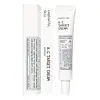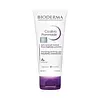What's inside
What's inside
 Key Ingredients
Key Ingredients

 Benefits
Benefits

 Concerns
Concerns

 Ingredients Side-by-side
Ingredients Side-by-side

Water
Skin ConditioningGlycerin
HumectantButylene Glycol
HumectantPropanediol
SolventCyclopentasiloxane
EmollientHelianthus Annuus Seed Oil
EmollientGlyceryl Acrylate/Acrylic Acid Copolymer
HumectantSodium Polyacrylate
AbsorbentXylitol
HumectantCaprylic Acid
CleansingGlyceryl Stearate
EmollientDimethicone
EmollientPanthenol
Skin ConditioningSodium Hyaluronate
HumectantCaprylyl Glycol
EmollientParfum
MaskingPentasodium Tetracarboxymethyl Heptadecanoyl Dipeptide-12
AntiseborrhoeicWater, Glycerin, Butylene Glycol, Propanediol, Cyclopentasiloxane, Helianthus Annuus Seed Oil, Glyceryl Acrylate/Acrylic Acid Copolymer, Sodium Polyacrylate, Xylitol, Caprylic Acid, Glyceryl Stearate, Dimethicone, Panthenol, Sodium Hyaluronate, Caprylyl Glycol, Parfum, Pentasodium Tetracarboxymethyl Heptadecanoyl Dipeptide-12
Water
Skin ConditioningGlycerin
HumectantParaffinum Liquidum
EmollientCaprylic/Capric Triglyceride
MaskingFructooligosaccharides
HumectantPolyglyceryl-4 Diisostearate/Polyhydroxystearate/Sebacate
EmulsifyingPropanediol
SolventXylitol
HumectantZinc Stearate
Cosmetic ColorantSodium Citrate
BufferingButylene Glycol
HumectantCapryloyl Glycine
CleansingCopper Sulfate
Skin ConditioningSodium Hydroxide
BufferingSodium Hyaluronate
HumectantZinc Sulfate
AntimicrobialVitis Vinifera Vine Extract
Skin ConditioningLaureth-3
EmulsifyingAsiaticoside
AntioxidantMadecassic Acid
Skin ConditioningAsiatic Acid
Skin ConditioningLaminaria Ochroleuca Extract
Skin ConditioningHydroxyethylcellulose
Emulsion StabilisingAcetyl Dipeptide-1 Cetyl Ester
Skin ConditioningMannitol
HumectantPotassium Sorbate
PreservativeRhamnose
HumectantWater, Glycerin, Paraffinum Liquidum, Caprylic/Capric Triglyceride, Fructooligosaccharides, Polyglyceryl-4 Diisostearate/Polyhydroxystearate/Sebacate, Propanediol, Xylitol, Zinc Stearate, Sodium Citrate, Butylene Glycol, Capryloyl Glycine, Copper Sulfate, Sodium Hydroxide, Sodium Hyaluronate, Zinc Sulfate, Vitis Vinifera Vine Extract, Laureth-3, Asiaticoside, Madecassic Acid, Asiatic Acid, Laminaria Ochroleuca Extract, Hydroxyethylcellulose, Acetyl Dipeptide-1 Cetyl Ester, Mannitol, Potassium Sorbate, Rhamnose
 Reviews
Reviews

Ingredients Explained
These ingredients are found in both products.
Ingredients higher up in an ingredient list are typically present in a larger amount.
Butylene Glycol (or BG) is used within cosmetic products for a few different reasons:
Overall, Butylene Glycol is a safe and well-rounded ingredient that works well with other ingredients.
Though this ingredient works well with most skin types, some people with sensitive skin may experience a reaction such as allergic rashes, closed comedones, or itchiness.
Learn more about Butylene GlycolGlycerin is already naturally found in your skin. It helps moisturize and protect your skin.
A study from 2016 found glycerin to be more effective as a humectant than AHAs and hyaluronic acid.
As a humectant, it helps the skin stay hydrated by pulling moisture to your skin. The low molecular weight of glycerin allows it to pull moisture into the deeper layers of your skin.
Hydrated skin improves your skin barrier; Your skin barrier helps protect against irritants and bacteria.
Glycerin has also been found to have antimicrobial and antiviral properties. Due to these properties, glycerin is often used in wound and burn treatments.
In cosmetics, glycerin is usually derived from plants such as soybean or palm. However, it can also be sourced from animals, such as tallow or animal fat.
This ingredient is organic, colorless, odorless, and non-toxic.
Glycerin is the name for this ingredient in American English. British English uses Glycerol/Glycerine.
Learn more about GlycerinPropanediol is an all-star ingredient. It softens, hydrates, and smooths the skin.
It’s often used to:
Propanediol is not likely to cause sensitivity and considered safe to use. It is derived from corn or petroleum with a clear color and no scent.
Learn more about PropanediolSodium Hyaluronate is hyaluronic acid's salt form. It is commonly derived from the sodium salt of hyaluronic acid.
Like hyaluronic acid, it is great at holding water and acts as a humectant. This makes it a great skin hydrating ingredient.
Sodium Hyaluronate is naturally occurring in our bodies and is mostly found in eye fluid and joints.
These are some other common types of Hyaluronic Acid:
Learn more about Sodium HyaluronateWater. It's the most common cosmetic ingredient of all. You'll usually see it at the top of ingredient lists, meaning that it makes up the largest part of the product.
So why is it so popular? Water most often acts as a solvent - this means that it helps dissolve other ingredients into the formulation.
You'll also recognize water as that liquid we all need to stay alive. If you see this, drink a glass of water. Stay hydrated!
Learn more about WaterXylitol is a humectant and prebiotic. It can help with dry skin.
In studies, xylitol has been shown to improve dry skin. It decreased transepidermal water loss, or when water passes through the skin and evaporates. Xylitol also showed to help improve the biomechanical properties of the skin barrier.
The prebiotic property of xylitol may also help reinforce our skin's natural microbiome. Having a healthy microbiome prevents infection by bad bacteria and helps with hydration.
As a humectant, Xylitol helps draw moisture from both the air and from deeper skin layers. This helps keep skin hydrated.
Xylitol is a sugar alcohol and commonly used as a sugar substitute. It is naturally occurring in plants such as strawberries and pumpkin.
Learn more about Xylitol